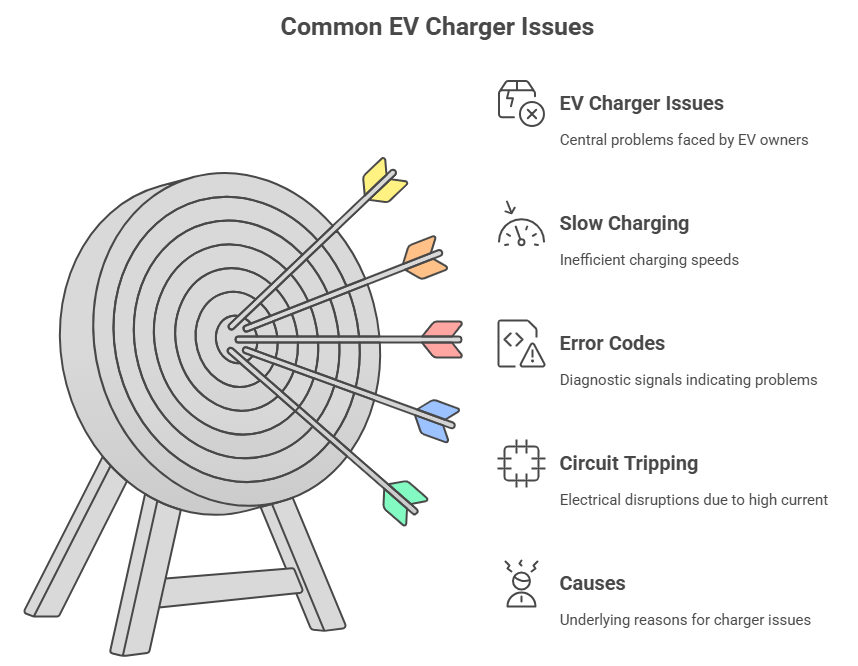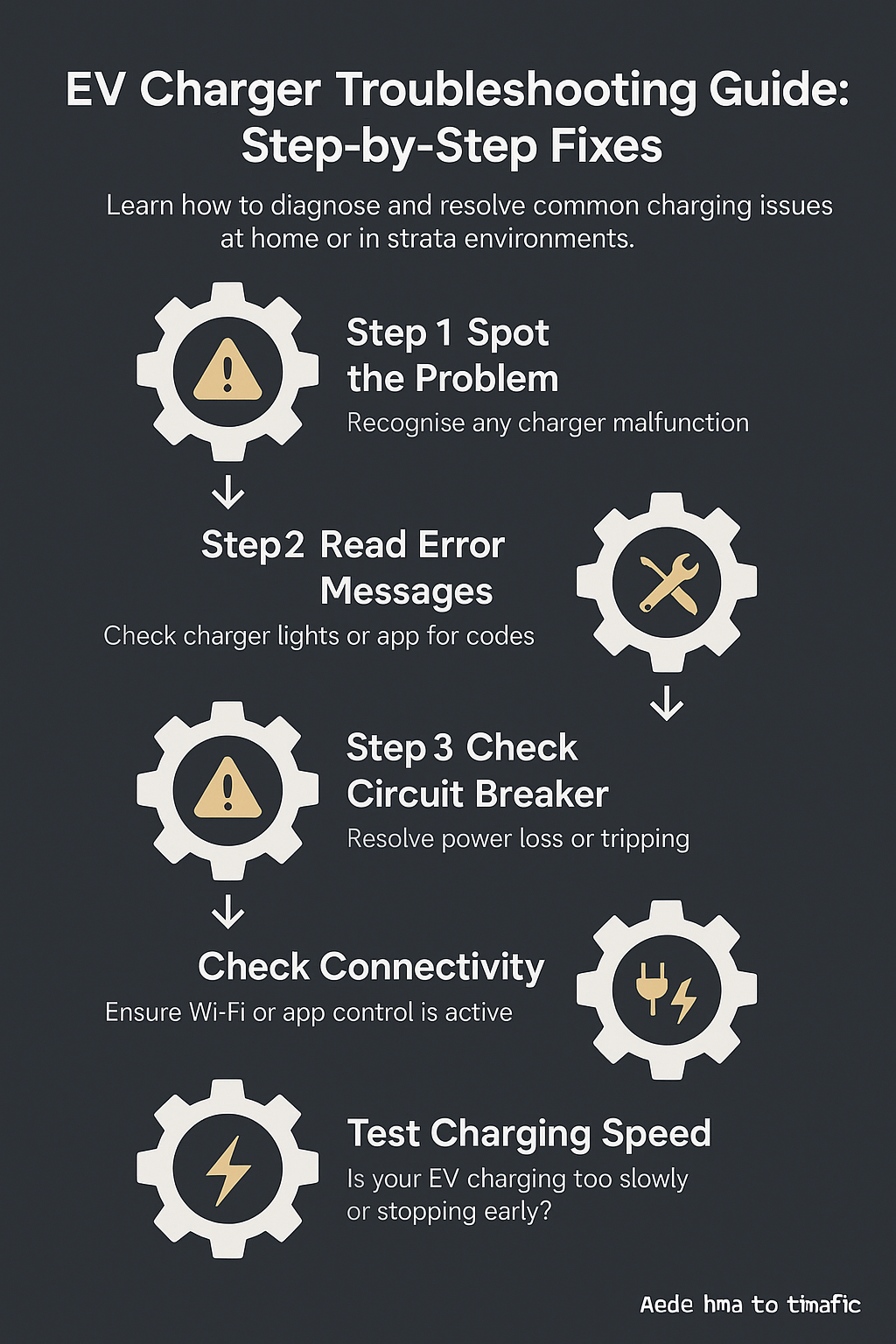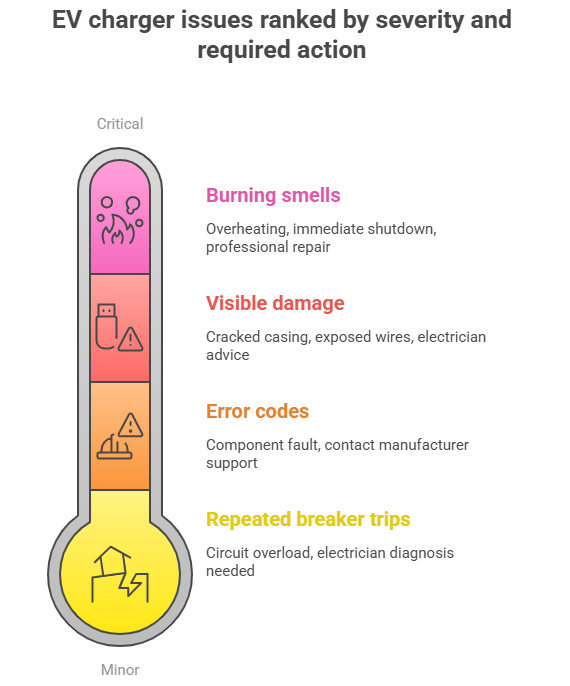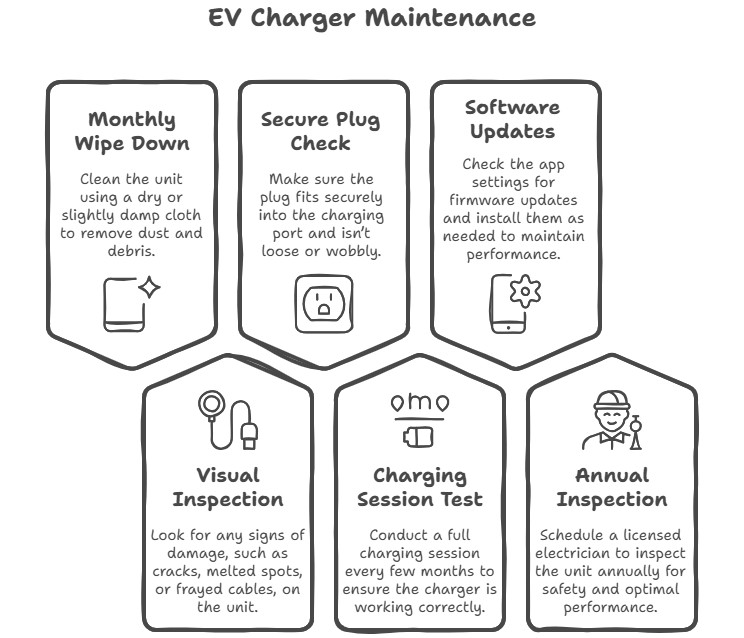If your EV charger isn’t working properly—whether it’s charging slowly, flashing error codes, or tripping your circuit—don’t panic. This guide to EV charger troubleshooting covers the most common home charging issues in Australia and how to fix them. Whether you’re plugging into a wall unit in your garage or using a shared charger in an apartment building, we’ll help you diagnose what’s wrong and when it’s time to call a professional. From slow charging to safety switches flipping, here’s how to get your EV charging station back on track safely and quickly.
If you drive an electric vehicle, chances are you’re plugging in at home most nights. And whether you’ve got a dedicated wall unit in your garage or a shared EV charger in an apartment carpark, keeping that gear in good shape is vital.
Like any other bit of electrical kit, EV chargers can chuck a wobbly now and then – but many issues are minor and easily fixed. Others may need a professional eye. This guide walks you through what can go wrong, how to deal with it, and when to bring in the pros. Whether you’re after home EV charging tips or trying to fix a charger not working properly, read on.
EV charger maintenance involves regular cleaning, safety checks, and occasional servicing to ensure optimal performance, safety, and charger lifespan. This includes inspecting cables, keeping software up to date, cleaning connections, and scheduling annual professional checks.
Looking after your EV charger: Key takeaways
- Start with the basics – check your power supply, inspect the cable, reboot the charger, and check app settings or firmware. These simple steps can solve many “charger not working” complaints.
- Slow charging isn’t always normal – if your EV charger is taking too long or not completing a full charge, it could point to a fault in the cable, power supply, or firmware. These are fixable with some basic EV charger troubleshooting.
- Tripped circuits or error codes need attention – if your charger keeps flipping breakers or flashing warnings, don’t ignore it. It may be a sign of overloaded circuits, damaged parts, or software issues.
- Know when to stop and call a pro – repeated trips, overheating, physical damage, or persistent faults are red flags. A licensed electrician should always handle wiring, replacements, or internal faults.
- Regular EV charger maintenance goes a long way – do a monthly visual check, test full charges quarterly, and book a yearly inspection to avoid big repair bills and extend charger life.
- Strata and apartment EV charging setups need a plan – for shared chargers, schedule maintenance, keep firmware up to date, and educate users on safe practices.
Table of contents
Common EV charger issues
While most chargers are built to last, they can sometimes act up. Here are the three most common gripes Australian EV owners report when it comes to EV charger troubleshooting:

1. Slow or incomplete charging
Your car’s been plugged in all night, but it’s only added 30%? That can throw a spanner in the works, especially if you have a drive planned the next day. Sometimes this is expected – a standard 10A general power outlet (GPO) charges at around 2.4kW, which is quite slow. But if you’re on a dedicated 7kW or 11kW charger and things still crawl, or your GPO is only delivering 1kW, something’s not right.
Causes can include voltage fluctuations, an overloaded circuit, or a damaged cable. If the charge stops altogether before hitting 100%, it might be a glitch in the charger or car software, or an issue with the communication between the two. These types of problems are classic signs when you’re searching for a slow EV charging fix.
2. Error codes or connectivity issues
Most modern chargers flash lights or show codes when there’s a hiccup – overheating, poor earthing, or software issues. Smart chargers might also go offline if there’s a Wi-Fi dropout or app issue.
Sometimes it’s the car kicking up a fuss – if your dashboard says “charging error”, it’s worth checking if the same issue happens at a public charger. A key part of EV charger maintenance is learning to decode these errors and knowing what to try first.
3. Circuit breaker tripping or outages
This one’s all too common: plug in your EV, and bang – the house goes dark. EV chargers draw hefty current, and if your setup isn’t quite up to scratch (old switchboard, overloaded circuit), it can trip the breaker.
If it keeps happening, don’t just flick it back on and hope for the best. A circuit that trips frequently could indicate an overload or that a safety device (RCD/ground fault detector) is detecting a problem that needs a closer look.
Troubleshooting checklist

Before calling in the cavalry, there are a few things you can do yourself to rule out various issues and pinpoint the cause. Here’s a step-by-step rundown of EV charger troubleshooting basics:
1. Inspect the cable and plug
First things first, turn off the charger and take a good look at the cable. Any frays, cracks, dark smoky stains or signs of melting? If so, stop using it immediately and arrange a replacement. Check the plug and car inlet too – dirt, corrosion, smashed bugs hiding in outlets or bent pins (unlikely but possible if there’s been tampering) can all mess with charging.
2. Check the power supply
Head to your switchboard and see if the EV charger’s breaker or safety switch has flipped. If you have other appliances running, make sure they are all turned off (you could simply be running too many devices on the same circuit.) Try resetting the breaker safety switch once, and start the car charging again. If it trips again, and nothing else is running, that could be a sign of a fault or that your circuit needs an upgrade – stop right there and call an electricity.
3. Reboot the charger
It’s the classic IT solution: turn it off and on again. If you are using a mobile charger, pull it out, check the power switch and plug it back in again. If you’re using a wall charger, sometimes a simple reset clears the gremlins. Power the charger off at the isolator or breaker, wait half a minute, then power it back on. Some units also have a reset button – check the manual.
4. Check the app and firmware
For smart chargers, open the app and check any error messages or whether the software is in need of an update. A firmware refresh can sometimes fix quirky behaviour. If your charger is not connected to an app and has an LED screen with error codes, check the manual to see what they mean. Also make sure your charger’s still connected to your Wi-Fi.
5. Rule out the car
Try a different EV (if you can) to see if the charger plays nicely with another car. Or try your EV on a public charger or other charging device, such as a portable charging cable. This helps figure out whether the problem lies with the charger or the vehicle.
When to call a professional
Some issues are best left to the experts – especially anything involving internal wiring, tripping circuits, or damaged parts.

When to Call a licensed electrician:
- Burning smells, hot plugs, or dark smoky patches: Danger Will Robinson! If your charger unit, plug, or cable feels hot to the touch, is discoloured from heat, or you notice a burning plastic smell or charring, turn off the charger immediately. Overheating indicates a serious electrical fault – possibly an internal short, poor wiring connection, or cable issue – that could lead to fire. Do not use that charger again until it’s inspected and repaired by a professional.
- Other visible damage: Likewise, any cracked casing, exposed wires, or melted components on the charging station or cable are an immediate red flag. Cables or connectors with any kind of visible damage may need repair or replacement – ask your electrician for advice. Similarly, if the charger has been impacted (e.g. hit by a car or water-damaged in a flood), have it professionally assessed before use.
- Repeated breaker or RCD trips: The occasional circuit trip is OK, but if every charging session trips your circuit breaker or safety switch, do not keep resetting it. Repeated tripping is a strong sign of an electrical fault or circuit overload that needs an electrician’s diagnosis. Your electrician may need to upgrade your circuit or repair a fault in the charger. Until then, avoid using the charger to prevent any hazard.
- Error codes that keep coming back or a charger that just won’t turn on: If your charger continues to display the same error message or warning light even after basic troubleshooting (resets, etc.), it likely indicates a component fault (for example, a failed relay, sensor, or controller in the unit). Likewise, if the charger won’t power on at all, or keeps aborting the charge with errors, it’s time for expert help. Do not open the unit yourself; start with a call to your charger manufacturer’s support line. If under warranty, they may need to send out a licensed technician with the tools to diagnose internal faults safely.
- You need to move, replace or upgrade the unit: You should call a professional if you suspect the existing wiring is insufficient or if you want to install a higher-capacity charger. Upgrading from a single-phase to three-phase charger, adding load management systems, or relocating a charger all require a licensed electrician. They will ensure the installation meets Australian standards and local regulations. Never attempt to rewire or install EV charging equipment on your own; besides safety issues, it’s illegal to do unlicensed electrical work in Australia
EV Charger Maintenance Checklist
Keeping your EV charger in good condition doesn’t require much—just consistent, simple upkeep. Here’s a quick maintenance checklist:

- Wipe the unit with a dry or slightly damp cloth monthly
- Visually check for cracks, melted spots, or frayed cables
- Ensure the plug is fitting securely and isn’t loose
- Test the charger completes a full session every few months
- Check app settings or perform firmware updates if required
- Book a licensed electrician to inspect the unit annually
Typical EV Charging Maintenance Costs:
How much it costs to fix and EV charger depends on the cause of the malfunction. A basic call-out fee in Australia ranges from $70 to $130. Hourly rates sit between $80 and $100.
If parts are needed (like a new cable or circuit breaker), you’ll need to pay for these. If your unit is under warranty, check with them first before going ahead and paying for anything.
Replacing a charger or upgrading your circuit board and wiring can cost from $800 to over $1,500 – or more – depending on the complexity and size of the job. For new installs, tools like Solar Choice can help you compare installer quotes and find a fair deal.
Maintenance schedule
EV charger maintenance doesn’t need to be complicated. Staying on top of upkeep can stop issues before they start. Here’s a simple maintenance routine:
Monthly:
- Do a visual check for damage or wear
- Make sure the cable’s not kinked, cracked or frayed
- Wipe down the unit (barely damp or dry cloth only)
Quarterly:
- Plug in and check the charger completes a full session
- Listen for odd noises or feel for excess heat
- Check the app for updates or connection issues
Annually:
- Book a licensed electrician to do a full inspection. They’ll test electrical safety features, earth connection and internal components
- This is especially important if your charger is outdoors or in heavy use
Tips for charging your EV safely
Use a dedicated circuit
EV chargers should have their own power line – don’t piggyback off existing sockets. This can also be an opportunity to get a 15a or 32a dedicated power outlet for your EV. A dedicated circuit for EV charging prevents overloads and keeps charging rates stable.
Don’t use cheap adapters or extension cords
They’re not built for sustained high power. Using them can cause overheating or even fire if you have to use an extension cord, use a heavy duty cord rated above the amperage you plan to charge at. Consider plugging a breaker unit between your power outlet and mobile cable, if you aren’t using a wall charger. Better still, if your charger doesn’t reach, get a licensed electrician to move it or add a proper outlet.
Be weather-smart
Avoid charging during storms or when your car or cable is wet. Water and electricity aren’t mates. If your charger’s outside, consider adding a weatherproof enclosure.
Pay attention to warning lights and messages
They’re not there for show. If something’s blinking red or throwing an error code, investigate or get help – don’t ignore it and hope it’ll go away.
For apartment and strata chargers
Make sure there’s a maintenance plan in place. Clean the units, keep firmware up-to-date, and set clear rules for usage. Chargers in shared spaces tend to get more wear, so they need more love.
In Conclusions
EV home charging is a huge convenience, but it’s easy to forget it needs care – until something goes wrong. By doing a few quick checks now and then, and knowing when to step back and call in the experts, you’ll save yourself headaches and keep your charger humming along. Whether you’re chasing a slow EV charging fix or wondering why your charger’s not working like it used to, taking small steps early is the smart move.
If your current setup isn’t cutting it – whether it’s outdated, faulty, or just not fast enough – it might be time for an upgrade. Services like Solar Choice let you compare installation quotes from licensed local pros, so you can get the right charger at the right price.
Treat your EV charger like you would any other key part of your home – a little regular TLC, and it’ll return the favour every time you plug in.
Frequently Asked Questions (FAQs)
Yes, EV chargers require basic maintenance to ensure safety, performance, and longevity. This includes checking for wear and tear, cleaning the charger, updating software, and scheduling annual inspections by a licensed electrician.
– EV charger maintenance involves:
– Cleaning the charger and cable monthly
– Inspecting plugs and connectors for damage
– Checking for secure electrical connections
– Testing the charger’s performance quarterly
– Updating firmware if it’s a smart charger
– Booking a professional safety check annually
For hardwired or wall-mounted chargers, yes—it’s safe and designed for constant connection. For portable chargers, it’s generally safe if used correctly, but unplugging when not in use can reduce wear and potential hazards in extreme weather.
Key warning signs include:
– Repeated circuit breaker trips
– Error codes or flashing warning lights
– Overheating of cables or plugs
– Unusual sounds or burning smells
– Slow or incomplete charging despite full power input
Call a licensed electrician if:
– The charger trips your safety switch repeatedly
– You notice physical damage or overheating
– Your charger displays persistent error messages
– You need to upgrade, relocate, or replace the unit
Basic call-out fees in Australia range from $80–$130. Hourly electrician rates are typically $80–$100. Replacing components or upgrading wiring can cost $800 to $1,500+. If the unit is under warranty, check before authorising repairs.
- Available V2G EV Chargers in Australia Compared (2025) - 25 November, 2025
- Soltaro AC EV Charger – An Independent Review by Solar Choice - 19 September, 2025
- How Long to Charge an Electric Car? EV Charging Times (2025 Guide) - 19 September, 2025
